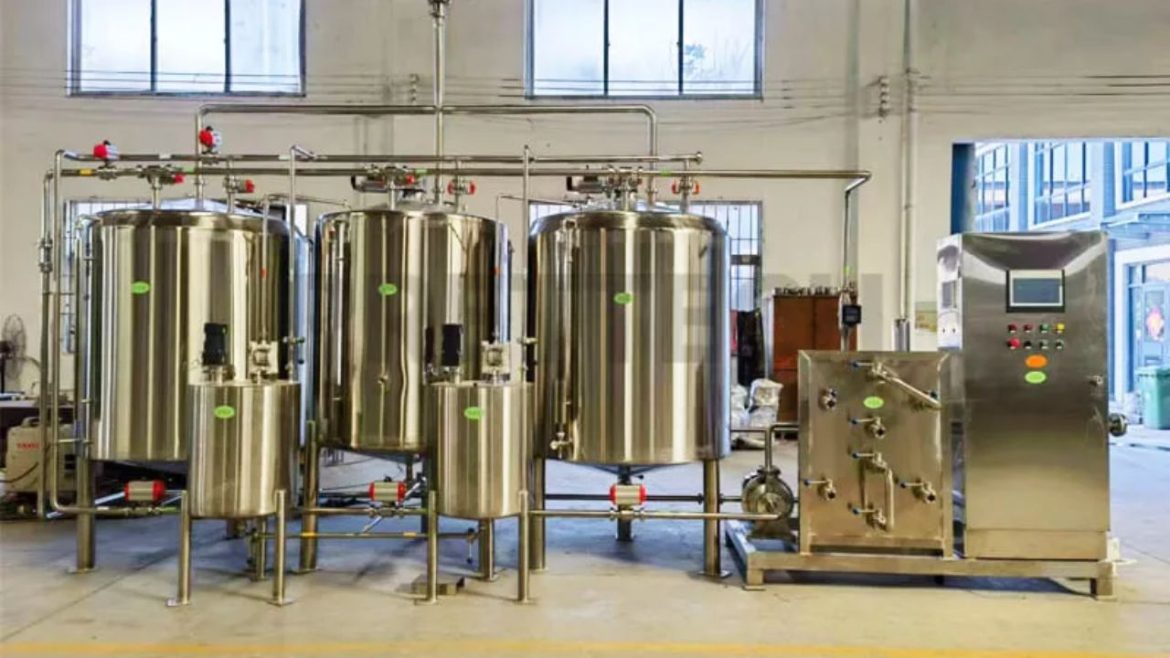Stainless steel tanks are necessary for winemaking because of their strong properties and uniqueness, which positively impact wine quality preservation. Still, cleaning fermentation tanks can be tricky, particularly in large-scale systems and intricate designs. While effective, it can be a very time-consuming and effort-consuming process.
This is where the Clean-in-Place system steps in. The device provides a streamlined, automated solution that cleans and sanitizes thoroughly.
In this article, we discuss the benefits of CIP systems and outline a detailed guide on how they can efficiently clean stainless steel tanks.
What is a CIP System?
Clean-in-place (CIP) is an automated cleaning technology designed to clean tanks and associated equipment without manual disassembly. The system circulates cleaning agents, water, and disinfectants, cleaning every surface, even those hard-to-reach spaces.
The use of CIP systems in winemaking and other fields, such as food processing and pharmaceuticals, is broad because they are efficient, have consistent hygiene, and have high control standards.
What Are the Major Steps of the Clean-in-Place System?
Preparation
When we start the CIP process, we want to empty the tank so that no liquids or solids remain. It is imperative not to clog the system with all visible debris, like grape skins or sediment, and all the debris must be manually removed.
Inspect the tank for blockages and verify that the CIP system’s connections, including fittings and valves, are tightly secured.
Pre-Rinsing
During this step, warm water is circulated through the tank to rinse off loose particles, including residues like sugar, yeast, and pulp.
The water’s warmth helps soften any dried or sticky materials that might adhere to the interior surfaces. This initial rinse removes visible debris and primes the tank for cleaning solutions.
Main Cleaning
The system is discharged and then introduced into the system as an alkaline cleaning solution circulated through the tank during the main cleaning phase. This solution is intended to break down organic residues like natural sugars and biofilms that might build up with time.
Spray balls or rotary cleaning heads ensure the solution reaches every surface, including corners and seams. Allowing the solution to work for the recommended time ensures that even the most stubborn residues are effectively dissolved and removed.
Intermediate Rinsing
Following the main cleaning phase, clean water is used to flush out all traces of the cleaning solution. This intermediate rinsing step is essential to remove detergent residues that could interfere with the subsequent stages.
The tank is filled with water and circulated through it until it runs clear, so no remnants on the inside may affect the disinfection process or future wine lots.
Disinfection
As they enter the disinfection phase, a sterilization agent (such as peracetic acid or a chlorine-based disinfectant) is circulated throughout the tank. This agent is formulated particularly to remove microorganisms, including bacteria and mold.
The disinfectant can remain in the tank for a specified duration to ensure complete sanitation. This step guarantees the tank meets the strict hygiene standards required for winemaking by thoroughly neutralizing contaminants.
Final Rinsing
After sanitization, the tank is rigorously rinsed with fresh tap water to eliminate all traces of the sanitizing agent. This ensures that nothing chemical remains that would taint the aroma or taste or render the wine unsafe.
The water used in this phase must be clean and free of impurities to maintain the integrity of the wine. The rinsing continues until the tank is completely clean, with no visible foam or residue left behind.
Drainage
The cleaning process concludes with complete drainage of the tank. The rest of the water is removed thoroughly so it does not stagnate or become contaminated.
After draining, the tank can air dry naturally or be wiped down with a lint-free cloth to remove excess moisture. If the tank is adequately drained and dried, there is no suitable place for microbial growth while in storage.
Benefits of the CIP System
- Time Efficiency: While there is downtime, it’s automated, so the transitions between batches can be much quicker.
- Consistent Cleaning: Clean-in-place systems can achieve even coverage and complete cleaning of all tank surfaces and hard-to-reach areas.
- Labor Reduction: The labor costs and operational efficiency are reduced with minimal manual intervention.
- Enhanced Safety: Workers can avoid confined spaces and further exposure to hazardous chemicals.
- Cost-Effective Resource Use: CIP systems minimize the use of water-cleaning agents and waste.
- Regulatory Compliance: The unit meets stringent hygiene and safety standards applicable in winemaking and auxiliary industries.
Conclusion
The system is fast, clean, and efficient. The Clean-in-Place automated system is becoming a game changer when cleaning wine tanks. Cleaning processes become much easier, budget-friendly, and friendlier with less labor. CIP systems ensure consistent sanitation, complying with stringent hygiene standards that save time and labor.
Winemakers adopt a CIP system to be confident in making great wines, knowing the equipment is sparkling clean and ready to go to work.
